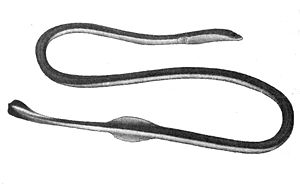Worms
| Worms | ||||||||||||
|---|---|---|---|---|---|---|---|---|---|---|---|---|

|
||||||||||||
| Systematics | ||||||||||||
|
||||||||||||
| Scientific name | ||||||||||||
| Moringuidae | ||||||||||||
| Jordan , 1885 |
Worm eels , also known as spaghetti eels , are long, thin, scaly fish whose dorsal and anal fins are only vaguely developed. They belong to the eel-like . What is unusual about them is the pronounced caudal fin, which is fork-shaped or three-lobed. Often one lip overlaps the other; mostly it is the upper lip. The worm eels occur predominantly in the Indo-Pacific region, a few species also in the western Atlantic . Moringua edwardsii is found in the waters of West India .
There are about twenty types of worm eels. In some species there are clear differences in the sexes. The females of the species Moringua edwardsii , for example, are almost twice as long as the males, have more vertebrae and the heart is much further back in the body. It was once thought to be of two different types.
Worms burrow headfirst into the ocean floor. They prefer sand or fine gravel. The way of life of the Pacific species Moringua macrochir is better known. As soon as their larvae have turned into fry, they dig in. Because they have tiny eyes and receding fins, they look very much like worms. The animals very rarely leave their den and then only at night until they become sexually mature. Then the eyes and fins get bigger. During this transformation, the animals begin to swim around at night to find a mate.
Systematics
There are two genera with a total of 14 species:
literature
- Joseph S. Nelson : Fishes of the World , John Wiley & Sons, 2006, ISBN 0-471-25031-7
Web links
- Wurmaale on Fishbase.org (English)